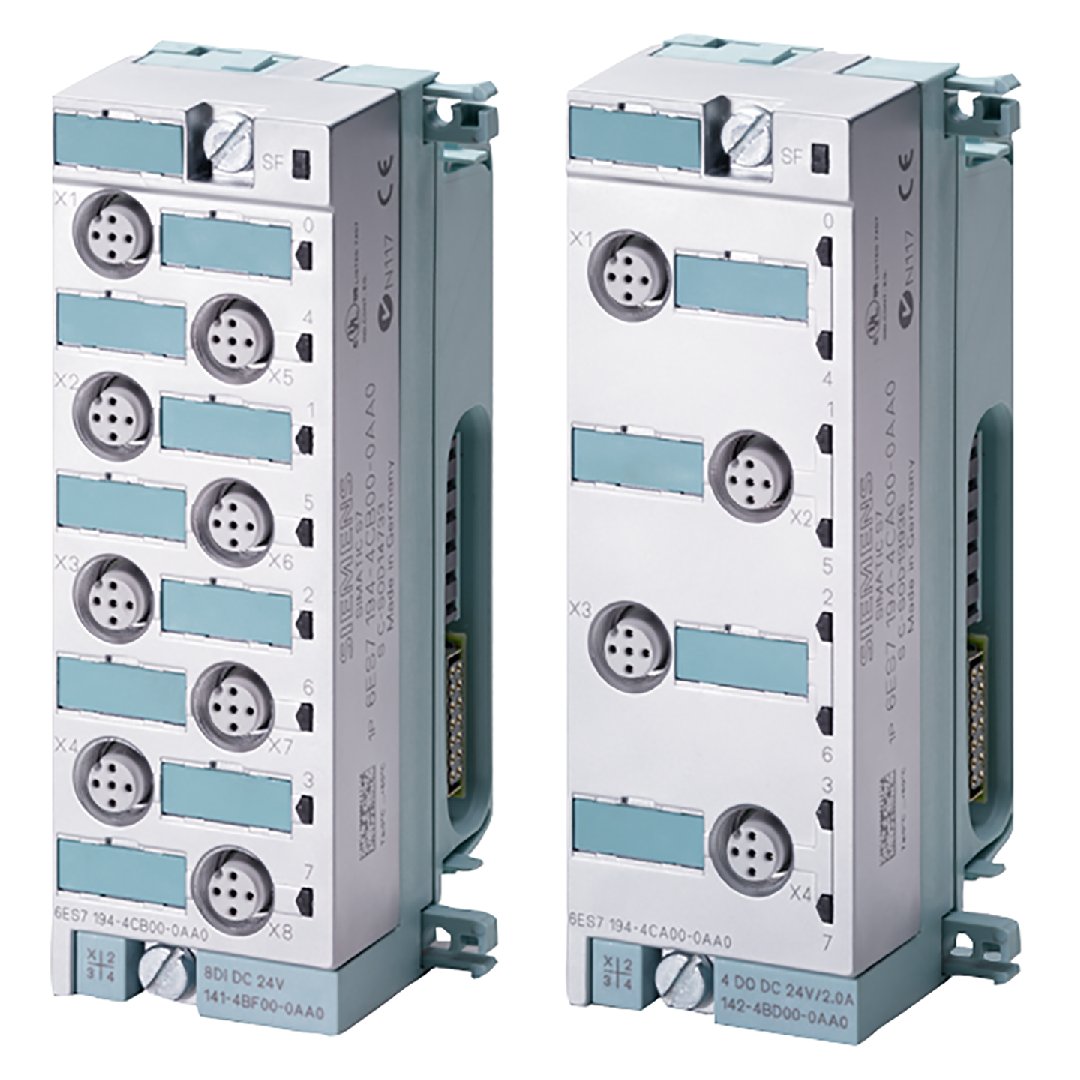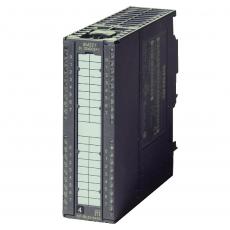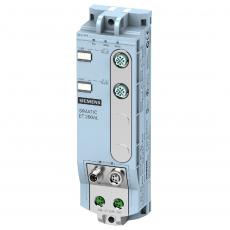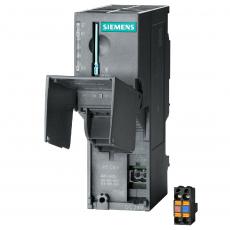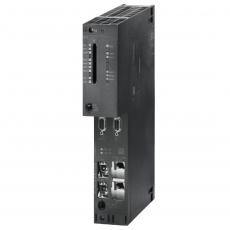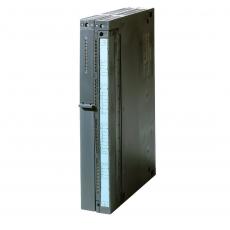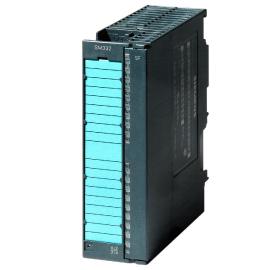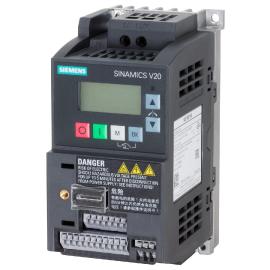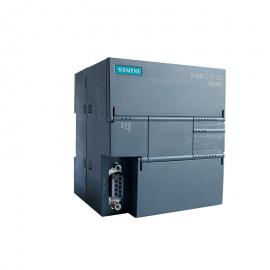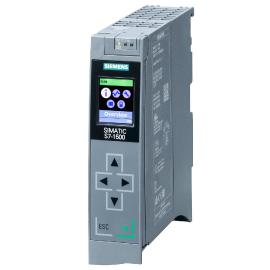- 西门子 CPU1511F-1PN S7-1500F
详细信息
品牌:西门子 型号:S7-1500F 核心数量:双核 适合类型:服务器 插槽类型:Socket 478 外频:200MHz 一级缓存:8KB 二级缓存:128KB 前端总线频率:1000MHz 64位处理器:是 包装:盒装 西门子 CPU1511F-1PN S7-1500F概述
- Entry-level CPU in the S7-1500F Controller product range
- Can be used for safety functions up to SIL 3 according to IEC 61508 and up to PLe according to ISO 13849
- Suitable for standard and fail-safe applications with medium requirements for program scope and processing speed
- Used as central controller in production lines with central and distributed I/O
- Supports PROFIsafe in centralized and distributed configurations
- PROFINET IO IRT interface with 2-port switch
- PROFINET IO controller for operating distributed I/O on PROFINET
- PROFINET I-Device for connecting the CPU as an intelligent PROFINET device under a SIMATIC or non-Siemens PROFINET I/O controller
- Isochronous mode
Note:
SIMATIC Memory Card required for operation of the CPU
应用
The CPU 1511-1 PN is the cost-effective entry-level CPU for standard and fail-safe applications with medium requirements for processing speed and speed of response in discrete production technology. With its work memory size, this CPU is also suitable for medium-sized applications. It can be used as a PROFINET IO controller or as distributed intelligence (PROFINET I-Device). The integrated PROFINET IO IRT interface is designed as a 2-port switch, enabling a linear topology to be set up in the system. In addition, the CPU offers comprehensive control functionalities via easy-to-configure blocks as well as the ability to connect drives via standardized PLCopen blocks.
设计
The CPU 1511F-1 PN has:
- A powerful processor:
The CPU achieves a command execution time as low as 60 ns per binary command. - Extensive work memory:
230 KB for program, 1 MB for data - SIMATIC Memory Cards as load memory;
permit additional functions such as datalog and archives - Flexible expansion options: single-tier configuration with max. 32 modules (CPU + 31 modules)
- Display with functions for
- Display of overview information such as station name, higher level designation, location designation, etc.
- Showing diagnostic information
- Showing module information
- Showing display settings
- Setting IP addresses
- Setting date and time
- Switching the operating mode
- Resetting the CPU to factory settings
- Disabling/enabling the display
- Enabling of protection levels
- Display of safety mode, overall signature and date of the last download with signature change
- PROFINET IO IRT interface for connecting distributed I/O via PROFINET
- Supports PROFIsafe in centralized and distributed configuration
功能
- Performance
- Faster command processing, depending on the CPU type, language extensions and new data types
- Even shorter response times of the CPUs due to considerably faster backplane bus
- Powerful network connection:
Each CPU is equipped with PROFINET IO IRT (2-port switch) as standard interface.
- Integrated technology
- Connection of analog and PROFIdrive-capable drives via standardized blocks (PLCopen)
- Support of speed-controlled and positioning axes as well as external encoders
- Trace functions for all CPU tags, both for diagnostics in real time and for sporadic error detection
- Comprehensive control functionalities, e.g. easily configurable blocks for automatic optimization of the control parameters for optimum control quality
- Security Integrated
- Password-based know-how protection against unauthorized read-out and modification of program blocks
- Copy protection for tying individual blocks to the serial number of the SIMATIC Memory Card: The block can only run if the configured memory card is inserted in the CPU.
- 4-level authorization concept:
Communication to operator panels can also be restricted. - Manipulation protection:
The controller recognizes changed or unauthorized transmissions of the engineering data.
- Design and handling
- Display of overview information:
E.g. Station name, plant designation, location identifier, etc., diagnostic information, module information, display settings. - Possible operations on the display:
Set addresses, set date and time, select operating mode of CPU, reset CPU to factory settings, disable/enable display, activate protection levels.
- Display of overview information:
- Integrated system diagnostics
- System diagnostics information is displayed consistently and in plain text in the display, TIA Portal, operator panels and web server, even for messages from the drives, and updated even if the CPU is in STOP mode.
- Integrated in the firmware of the CPU, no special configuration is required
- SIMATIC Memory Card (required for operation of the CPU)
- Used as plug-in load memory or for updating the firmware.
- Also for storing additional documents or csv files (for recipes and archives)
- Creation of data blocks for storage/reading of data via SFCs of the user program
- Datalog (archives) and recipes
- Storage of csv files for recipes and archives on the SIMATIC Memory Card;
easy access to plant-relevant operating data using Office tools and via web server - Easy access to configuration data of the machine by means of a web browser or SD card reader (two-way data exchange from and to the PLC)
- Storage of csv files for recipes and archives on the SIMATIC Memory Card;
- Programming of the standard program section
- Programming as of STEP 7 V12 SP1
- Programming of the fail-safe program section
- Programming of the safety-related program section with the "STEP 7 Safety Advanced" option package. STEP 7 Safety Advanced V12 can run under SIMATIC STEP 7 Professional V12 SP1.
技术规范
Article number
6ES7511-1FK02-0AB0
CPU 1511F-1PN, 225KB prog, 1MB data
General information
Product type designation
CPU 1511F-1 PN
HW functional status
FS03
Firmware version
V2.9
Product function
-
● I&M data
Yes; I&M0 to I&M3
-
● Isochronous mode
Yes; Distributed and central; with minimum OB 6x cycle of 625 µs (distributed) and 1 ms (central)
Engineering with
-
● STEP 7 TIA Portal configurable/integrated from version
V17 (FW V2.9) / V15 (FW V2.5) or higher; with older TIA Portal versions configurable as 6ES7511-1FK01-0AB0
Configuration control
via dataset
Yes
Display
Screen diagonal [cm]
3.45 cm
Control elements
Number of keys
8
Mode buttons
2
Supply voltage
Rated value (DC)
24 V
permissible range, lower limit (DC)
19.2 V
permissible range, upper limit (DC)
28.8 V
Reverse polarity protection
Yes
Mains buffering
-
● Mains/voltage failure stored energy time
5 ms
-
● Repeat rate, min.
1/s
Input current
Current consumption (rated value)
0.7 A
Current consumption, max.
0.95 A
Inrush current, max.
1.9 A; Rated value
I²t
0.02 A²·s
Power
Infeed power to the backplane bus
10 W
Power consumption from the backplane bus (balanced)
5.5 W
Power loss
Power loss, typ.
5.7 W
Memory
Number of slots for SIMATIC memory card
1
SIMATIC memory card required
Yes
Work memory
-
● integrated (for program)
225 kbyte
-
● integrated (for data)
1 Mbyte
Load memory
-
● Plug-in (SIMATIC Memory Card), max.
32 Gbyte
Backup
-
● maintenance-free
Yes
CPU processing times
for bit operations, typ.
60 ns
for word operations, typ.
72 ns
for fixed point arithmetic, typ.
96 ns
for floating point arithmetic, typ.
384 ns
CPU-blocks
Number of elements (total)
4 000; Blocks (OB, FB, FC, DB) and UDTs
DB
-
● Number range
1 ... 60 999; subdivided into: number range that can be used by the user: 1 ... 59 999, and number range of DBs created via SFC 86: 60 000 ... 60 999
-
● Size, max.
1 Mbyte; For DBs with absolute addressing, the max. size is 64 KB
FB
-
● Number range
0 ... 65 535
-
● Size, max.
150 kbyte
FC
-
● Number range
0 ... 65 535
-
● Size, max.
150 kbyte
OB
-
● Size, max.
150 kbyte
-
● Number of free cycle OBs
100
-
● Number of time alarm OBs
20
-
● Number of delay alarm OBs
20
-
● Number of cyclic interrupt OBs
20; With minimum OB 3x cycle of 500 µs
-
● Number of process alarm OBs
50
-
● Number of DPV1 alarm OBs
3
-
● Number of isochronous mode OBs
2
-
● Number of technology synchronous alarm OBs
2
-
● Number of startup OBs
100
-
● Number of asynchronous error OBs
4
-
● Number of synchronous error OBs
2
-
● Number of diagnostic alarm OBs
1
Nesting depth
-
● per priority class
24; Up to 8 possible for F-blocks
Counters, timers and their retentivity
S7 counter
-
● Number
2 048
Retentivity
-
— adjustable
Yes
IEC counter
-
● Number
Any (only limited by the main memory)
Retentivity
-
— adjustable
Yes
S7 times
-
● Number
2 048
Retentivity
-
— adjustable
Yes
IEC timer
-
● Number
Any (only limited by the main memory)
Retentivity
-
— adjustable
Yes
Data areas and their retentivity
Retentive data area (incl. timers, counters, flags), max.
128 kbyte; In total; available retentive memory for bit memories, timers, counters, DBs, and technology data (axes): 88 KB
Extended retentive data area (incl. timers, counters, flags), max.
1 Mbyte; When using PS 6 0W 24/48/60 V DC HF
Flag
-
● Size, max.
16 kbyte
-
● Number of clock memories
8; 8 clock memory bit, grouped into one clock memory byte
Data blocks
-
● Retentivity adjustable
Yes
-
● Retentivity preset
No
Local data
-
● per priority class, max.
64 kbyte; max. 16 KB per block
Address area
Number of IO modules
1 024; max. number of modules / submodules
I/O address area
-
● Inputs
32 kbyte; All inputs are in the process image
-
● Outputs
32 kbyte; All outputs are in the process image
per integrated IO subsystem
-
— Inputs (volume)
8 kbyte
-
— Outputs (volume)
8 kbyte
per CM/CP
-
— Inputs (volume)
8 kbyte
-
— Outputs (volume)
8 kbyte
Subprocess images
-
● Number of subprocess images, max.
32
Hardware configuration
Number of distributed IO systems
32; A distributed I/O system is characterized not only by the integration of distributed I/O via PROFINET or PROFIBUS communication modules, but also by the connection of I/O via AS-i master modules or links (e.g. IE/PB-Link)
Number of DP masters
-
● Via CM
4; A maximum of 4 CMs/CPs (PROFIBUS, PROFINET, Ethernet) can be inserted in total
Number of IO Controllers
-
● integrated
1
-
● Via CM
4; A maximum of 4 CMs/CPs (PROFIBUS, PROFINET, Ethernet) can be inserted in total
Rack
-
● Modules per rack, max.
32; CPU + 31 modules
-
● Number of lines, max.
1
PtP CM
-
● Number of PtP CMs
the number of connectable PtP CMs is only limited by the number of available slots
Time of day
Clock
-
● Type
Hardware clock
-
● Backup time
6 wk; At 40 °C ambient temperature, typically
-
● Deviation per day, max.
10 s; Typ.: 2 s
Operating hours counter
-
● Number
16
Clock synchronization
-
● supported
Yes
-
● in AS, master
Yes
-
● in AS, slave
Yes
-
● on Ethernet via NTP
Yes
Interfaces
Number of PROFINET interfaces
1
1. Interface
Interface types
-
● RJ 45 (Ethernet)
Yes; X1
-
● Number of ports
2
-
● integrated switch
Yes
Protocols
-
● IP protocol
Yes; IPv4
-
● PROFINET IO Controller
Yes
-
● PROFINET IO Device
Yes
-
● SIMATIC communication
Yes
-
● Open IE communication
Yes; Optionally also encrypted
-
● Web server
Yes
-
● Media redundancy
Yes; MRP Automanager according to IEC 62439-2 Edition 2.0
PROFINET IO Controller
Services
-
— PG/OP communication
Yes
-
— Isochronous mode
Yes
-
— Direct data exchange
Yes; Requirement: IRT and isochronous mode (MRPD optional)
-
— IRT
Yes
-
— PROFIenergy
Yes; per user program
-
— Prioritized startup
Yes; Max. 32 PROFINET devices
-
— Number of connectable IO Devices, max.
128; In total, up to 256 distributed I/O devices can be connected via AS-i, PROFIBUS or PROFINET
-
— Of which IO devices with IRT, max.
64
-
— Number of connectable IO Devices for RT, max.
128
-
— of which in line, max.
128
-
— Number of IO Devices that can be simultaneously activated/deactivated, max.
8; in total across all interfaces
-
— Number of IO Devices per tool, max.
8
-
— Updating times
The minimum value of the update time also depends on communication share set for PROFINET IO, on the number of IO devices, and on the quantity of configured user data
Update time for IRT
-
— for send cycle of 250 µs
250 μs to 4 ms; Note: In the case of IRT with isochronous mode, the minimum update time of 625 µs of the isochronous OB is decisive
-
— for send cycle of 500 µs
500 μs to 8 ms; Note: In the case of IRT with isochronous mode, the minimum update time of 625 µs of the isochronous OB is decisive
-
— for send cycle of 1 ms
1 ms to 16 ms
-
— for send cycle of 2 ms
2 ms to 32 ms
-
— for send cycle of 4 ms
4 ms to 64 ms
-
— With IRT and parameterization of "odd" send cycles
Update time = set "odd" send clock (any multiple of 125 µs: 375 µs, 625 µs ... 3 875 µs)
Update time for RT
-
— for send cycle of 250 µs
250 µs to 128 ms
-
— for send cycle of 500 µs
500 µs to 256 ms
-
— for send cycle of 1 ms
1 ms to 512 ms
-
— for send cycle of 2 ms
2 ms to 512 ms
-
— for send cycle of 4 ms
4 ms to 512 ms
PROFINET IO Device
Services
-
— PG/OP communication
Yes
-
— Isochronous mode
No
-
— IRT
Yes
-
— PROFIenergy
Yes; per user program
-
— Shared device
Yes
-
— Number of IO Controllers with shared device, max.
4
-
— activation/deactivation of I-devices
Yes; per user program
-
— Asset management record
Yes; per user program
Interface types
RJ 45 (Ethernet)
-
● 100 Mbps
Yes
-
● Autonegotiation
Yes
-
● Autocrossing
Yes
-
● Industrial Ethernet status LED
Yes
Protocols
PROFIsafe
Yes; V2.4 / V2.6
Number of connections
-
● Number of connections, max.
96; via integrated interfaces of the CPU and connected CPs / CMs
-
● Number of connections reserved for ES/HMI/web
10
-
● Number of connections via integrated interfaces
64
-
● Number of S7 routing paths
16
Redundancy mode
-
● H-Sync forwarding
Yes
Media redundancy
-
— Media redundancy
only via 1st interface (X1)
-
— MRP
Yes; MRP Automanager according to IEC 62439-2 Edition 2.0, MRP Manager; MRP Client
-
— MRP interconnection, supported
Yes; as MRP ring node according to IEC 62439-2 Edition 3.0
-
— MRPD
Yes; Requirement: IRT
-
— Switchover time on line break, typ.
200 ms; For MRP, bumpless for MRPD
-
— Number of stations in the ring, max.
50
SIMATIC communication
-
● PG/OP communication
Yes; encryption with TLS V1.3 pre-selected
-
● S7 routing
Yes
-
● S7 communication, as server
Yes
-
● S7 communication, as client
Yes
-
● User data per job, max.
See online help (S7 communication, user data size)
Open IE communication
-
● TCP/IP
Yes
-
— Data length, max.
64 kbyte
-
— several passive connections per port, supported
Yes
-
● ISO-on-TCP (RFC1006)
Yes
-
— Data length, max.
64 kbyte
-
● UDP
Yes
-
— Data length, max.
2 kbyte; 1 472 bytes for UDP broadcast
-
— UDP multicast
Yes; Max. 5 multicast circuits
-
● DHCP
Yes
-
● DNS
Yes
-
● SNMP
Yes
-
● DCP
Yes
-
● LLDP
Yes
-
● Encryption
Yes; Optional
Web server
-
● HTTP
Yes; Standard and user pages
-
● HTTPS
Yes; Standard and user pages
OPC UA
-
● Runtime license required
Yes
-
● OPC UA Client
Yes
-
— Application authentication
Yes
-
— Security policies
Available security policies: None, Basic128Rsa15, Basic256Rsa15, Basic256Sha256
-
— User authentication
"anonymous" or by user name & password
-
— Number of connections, max.
4
-
— Number of nodes of the client interfaces, max.
1 000
-
— Number of elements for one call of OPC_UA_NodeGetHandleList/OPC_UA_ReadList/OPC_UA_WriteList, max.
300
-
— Number of elements for one call of OPC_UA_NameSpaceGetIndexList, max.
20
-
— Number of elements for one call of OPC_UA_MethodGetHandleList, max.
100
-
— Number of simultaneous calls of the client instructions per connection (except OPC_UA_ReadList,OPC_UA_WriteList,OPC_UA_MethodCall), max.
1
-
— Number of simultaneous calls of the client instructions OPC_UA_ReadList,OPC_UA_WriteList and OPC_UA_MethodCall, max.
5
-
— Number of registerable nodes, max.
5 000
-
— Number of registerable method calls of OPC_UA_MethodCall, max.
100
-
— Number of inputs/outputs when calling OPC_UA_MethodCall, max.
20
-
● OPC UA Server
Yes; Data access (read, write, subscribe), method call, custom address space
-
— Application authentication
Yes
-
— Security policies
Available security policies: None, Basic128Rsa15, Basic256Rsa15, Basic256Sha256
-
— User authentication
"anonymous" or by user name & password
-
— Number of sessions, max.
32
-
— Number of accessible variables, max.
50 000
-
— Number of registerable nodes, max.
10 000
-
— Number of subscriptions per session, max.
20
-
— Sampling interval, min.
100 ms
-
— Publishing interval, min.
500 ms
-
— Number of server methods, max.
20
-
— Number of inputs/outputs per server method, max.
20
-
— Number of monitored items, max.
1 000; for 1 s sampling interval and 1 s send interval
-
— Number of server interfaces, max.
10 of each "Server interfaces" / "Companion specification" type and 20 of the type "Reference namespace"
-
— Number of nodes for user-defined server interfaces, max.
1 000
Further protocols
-
● MODBUS
Yes; MODBUS TCP
Isochronous mode
Equidistance
Yes
S7 message functions
Number of login stations for message functions, max.
32
Program alarms
Yes
Number of configurable program messages, max.
5 000; Program messages are generated by the "Program_Alarm" block, ProDiag or GRAPH
Number of loadable program messages in RUN, max.
2 500
Number of simultaneously active program alarms
-
● Number of program alarms
600
-
● Number of alarms for system diagnostics
100
-
● Number of alarms for motion technology objects
80
Test commissioning functions
Joint commission (Team Engineering)
Yes; Parallel online access possible for up to 5 engineering systems
Status block
Yes; Up to 8 simultaneously (in total across all ES clients)
Single step
No
Number of breakpoints
8
Status/control
-
● Status/control variable
Yes; without fail-safe
-
● Variables
inputs/outputs, bit memories, DBs, peripheral I/Os (without fail-safe), times, counters
-
● Number of variables, max.
-
— of which status variables, max.
200; per job
-
— of which control variables, max.
200; per job
Forcing
-
● Forcing
Yes; without fail-safe
-
● Forcing, variables
peripheral inputs/outputs (without fail-safe)
-
● Number of variables, max.
200
Diagnostic buffer
-
● present
Yes
-
● Number of entries, max.
1 000
-
— of which powerfail-proof
500
Traces
-
● Number of configurable Traces
4; Up to 512 KB of data per trace are possible
Interrupts/diagnostics/status information
Diagnostics indication LED
-
● RUN/STOP LED
Yes
-
● ERROR LED
Yes
-
● MAINT LED
Yes
-
● STOP ACTIVE LED
Yes
-
● Connection display LINK TX/RX
Yes
Supported technology objects
Motion Control
Yes; Note: The number of technology objects affects the cycle time of the PLC program; selection guide via the TIA Selection Tool
-
● Number of available Motion Control resources for technology objects
800
-
● Required Motion Control resources
-
— per speed-controlled axis
40
-
— per positioning axis
80
-
— per synchronous axis
160
-
— per external encoder
80
-
— per output cam
20
-
— per cam track
160
-
— per probe
40
-
● Positioning axis
-
— Number of positioning axes at motion control cycle of 4 ms (typical value)
5
-
— Number of positioning axes at motion control cycle of 8 ms (typical value)
10
Controller
-
● PID_Compact
Yes; Universal PID controller with integrated optimization
-
● PID_3Step
Yes; PID controller with integrated optimization for valves
-
● PID-Temp
Yes; PID controller with integrated optimization for temperature
Counting and measuring
-
● High-speed counter
Yes
Standards, approvals, certificates
Highest safety class achievable in safety mode
-
● Performance level according to ISO 13849-1
PLe
-
● SIL acc. to IEC 61508
SIL 3
Probability of failure (for service life of 20 years and repair time of 100 hours)
-
— Low demand mode: PFDavg in accordance with SIL3
< 2.00E-05
-
— High demand/continuous mode: PFH in accordance with SIL3
< 1.00E-09
Ambient conditions
Ambient temperature during operation
-
● horizontal installation, min.
-25 °C; No condensation
-
● horizontal installation, max.
60 °C; Display: 50 °C, at an operating temperature of typically 50 °C, the display is switched off
-
● vertical installation, min.
-25 °C; No condensation
-
● vertical installation, max.
40 °C; Display: 40 °C, at an operating temperature of typically 40 °C, the display is switched off
Ambient temperature during storage/transportation
-
● min.
-40 °C
-
● max.
70 °C
Altitude during operation relating to sea level
-
● Installation altitude above sea level, max.
5 000 m; Restrictions for installation altitudes > 2 000 m, see manual
configuration / header
configuration / programming / header
Programming language
-
— LAD
Yes; incl. failsafe
-
— FBD
Yes; incl. failsafe
-
— STL
Yes
-
— SCL
Yes
-
— GRAPH
Yes
Know-how protection
-
● User program protection/password protection
Yes
-
● Copy protection
Yes
-
● Block protection
Yes
Access protection
-
● Password for display
Yes
-
● Protection level: Write protection
Yes; Specific write protection both for Standard and for Failsafe
-
● Protection level: Read/write protection
Yes
-
● Protection level: Write protection for Failsafe
Yes
-
● Protection level: Complete protection
Yes
programming / cycle time monitoring / header
-
● lower limit
adjustable minimum cycle time
-
● upper limit
adjustable maximum cycle time
Dimensions
Width
35 mm
Height
147 mm
Depth
129 mm
Weights
Weight, approx.
405 g
-
-
产品搜索
 扫一扫,手机浏览
扫一扫,手机浏览
